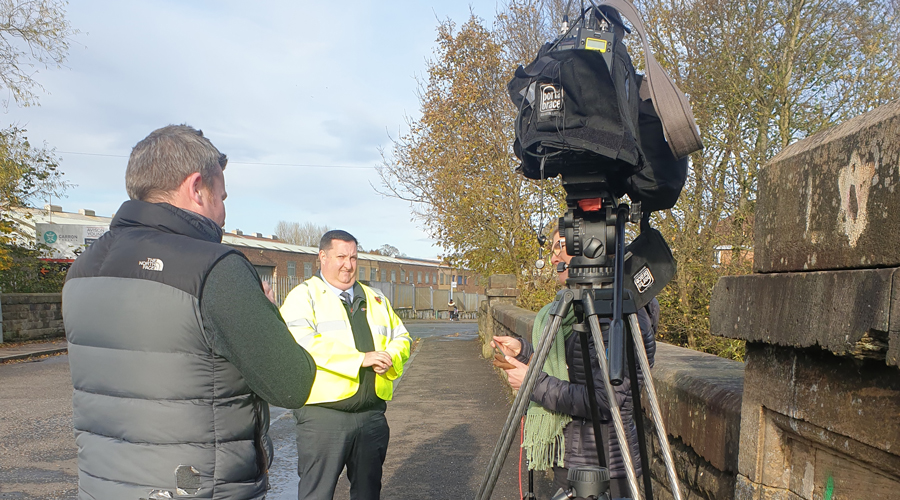The risk of flooding is on the increase across the world because of climate change, which can cause more frequent intense rainfall and higher sea levels. In Scotland, the town of Grangemouth and the areas surrounding it are affected by both tidal and river flooding, making it unique.
Over the past few years, occurrences of flooding have increased because of climate change. On the east coast of Scotland, the town of Grangemouth and six surrounding communities are at risk of flooding from both rivers and sea. The company I work for, Jacobs, helps solve some of the world’s toughest challenges like water scarcity, climate change resiliency and aging infrastructure – and we’re working with the local authority, Falkirk Council, to protect homes, business and residents by addressing the flood risk in Grangemouth and six nearby areas.
The Grangemouth Flood Protection Scheme is not only the highest priority flood protection scheme in Scotland but also the largest in Scotland and one of the most significant in the UK. When it’s complete it will be made up of 27km of river and coastal flood defence walls and embankments, flood gates and surface water management measures. The scheme is unique because it covers both coastal flooding from the estuary of the River Forth which flows into the North Sea, and flooding from three rivers – the River Carron, River Avon and the Grange Burn.
The scheme will not only protect homes, businesses and livelihoods across Grangemouth and the surrounding communities, but also road and rail transport infrastructure and the port and nearby refinery. These are key pieces of national infrastructure in Scotland and important to the local, Scottish and UK economy. By keeping transport links open during flood events, goods can still move through the Port of Grangemouth with limited impact.
I’ve spent nearly 25 years working on water and environment-related projects in Scotland. As a flood risk management expert, I co-ordinate the planning and development of the flood protection scheme, leading a team of around 40 engineers and scientists. We ensure everyone who lives and works locally has a chance to have their say on the flood defences. My team is designing, planning and managing the implementation of the new flood defences and has been working with Falkirk Council on the project since 2012.

Alan being interviewed about the scheme, photo courtesy of Jacobs
This flood protection scheme is very complicated because of its scale, geographic spread, and the complex urban and industrial setting. Protecting local communities is at the heart of the scheme. We want to help improve the resilience of the communities in the areas at risk of flooding, so they can cope with the threats posed by severe weather events more often in future.
To effectively defend Grangemouth and the other communities, we’re planning to install 27km of flood defences, averaging around 1.5 metres in height. These vary in design and include embankments, walls, floodgates and pumping stations. They need to effectively manage river, coastal and surface water and cope with flooding from three rivers and the Forth Estuary, which impact many different environments from private gardens and public open spaces to major industrial complexes.
There are also many significant environmental factors that we need to consider, like the Firth of Forth Special Protected Area which is a habitat for large numbers of birds. There are also lots of opportunities to enhance the environment through this scheme, for example by creating rich and diverse habitats for animals, fish and birds.
The scheme aims to deliver other significant benefits, such as creating new job opportunities, improving access, improving habitats and biodiversity.
Projects of this nature are very varied and exciting and involve most engineering disciplines from ground engineering to hydraulic design to structural design. There are many non-engineering disciplines working on the scheme too, like ecology, landscape, communications and economics. This means that my daily workload can change frequently from discussions on finance, planning workload for the team and discussing complex ground conditions through to client and stakeholder meetings.
The flood protection scheme will have a uniquely developed STEM education programme for local schools to look at flooding and its effects, as well as gathering ideas from young people on the project. This is important so that young people from all of the communities affected can input to the scheme. The STEM programme will develop lessons for teachers to deliver to young people in both primary and secondary schools and will also enable them to meet virtually with a flooding expert who can answer any questions they may have.
Flood protection schemes like Grangemouth can take a long time from start to finish – we expect this one to take around 10 years to build. By designing a scheme that’s flexible, we can help the area withstand possible future increases in rainfall and sea level rises, as well as more severe and frequent storm surges that might occur because of climate change – helping the local community to be more resilient in years to come.
Download PDF
If you wish to save, or print, this article please use this pdf version »


